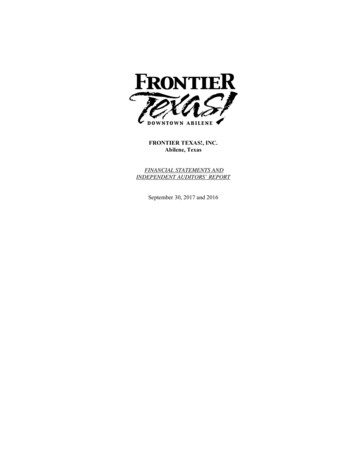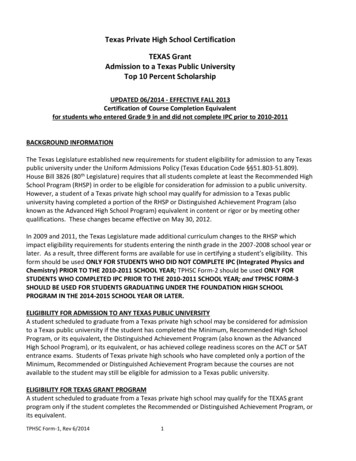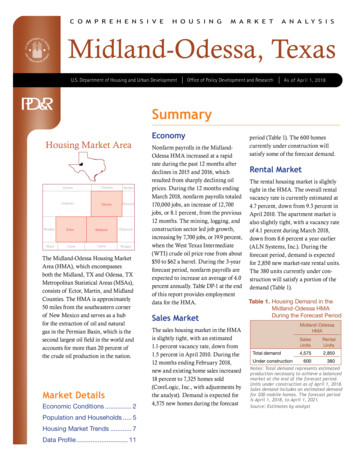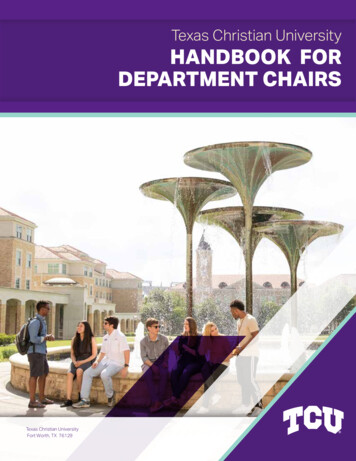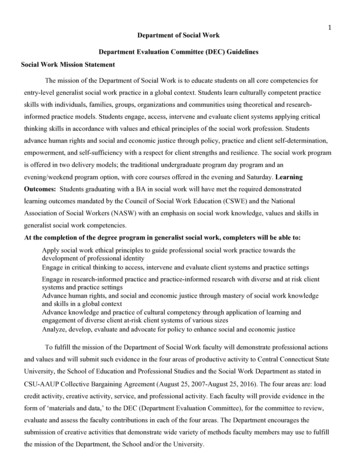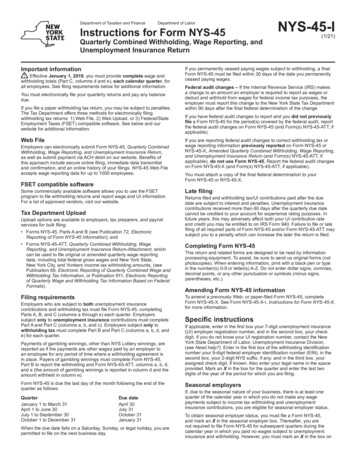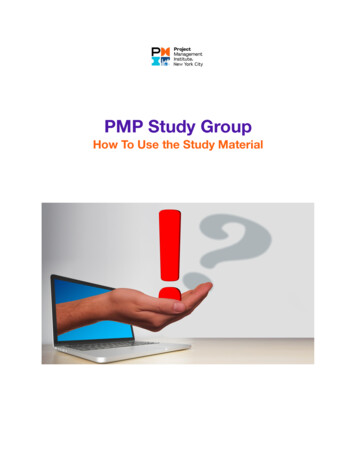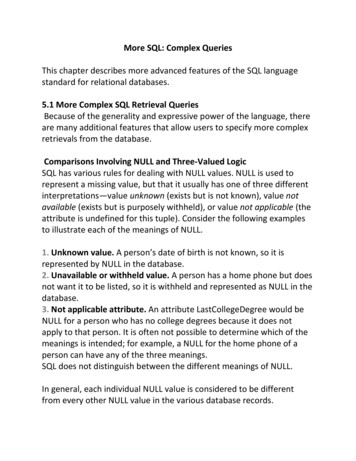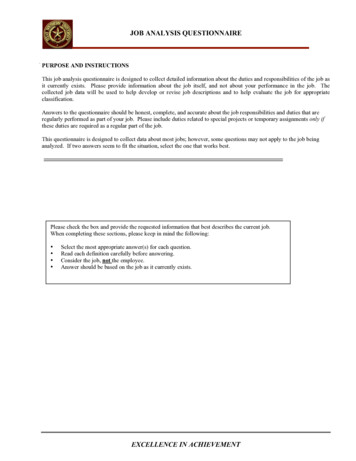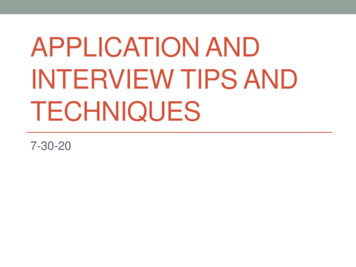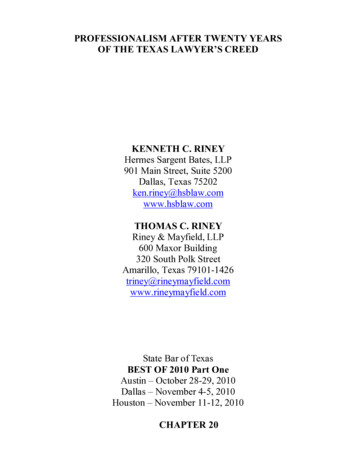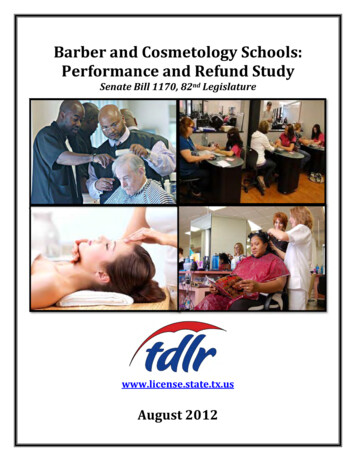
Transcription
Barber and Cosmetology Schools:Performance and Refund StudySenate Bill 1170, 82nd Legislaturewww.license.state.tx.usAugust 2012
Table of ContentsSection One: Overview1Section Two: Input, Research, and Methods of Inclusion3Section Three: Study of Current Refund Policies6Section Four: Comparison and Analysis11Section Five: Options and Recommendations15Appendix A: Barber and Cosmetology Refund Study Data19Appendix B: The National Accrediting Commission ofCosmetology Arts and Sciences Study Data48
Section One:Overview1
OverviewThe Texas Department of Licensing and Regulation (TDLR) was asked to study and report onbarber and cosmetology school performance, including payment of refunds andrecommendations for improvements to the refund policy and school performance. TDLRconsulted with its advisory boards, national accrediting agencies, school representatives, andother interested parties in conducting the study.To illustrate the scope of impact, the changes in school and student populations in the last threeyears are shown below (as of July 2012):TOTALSCHOOLSPRIVATESCHOOLS3 YRPRIVATECHANGETOTALSTUDENTS3 YRSTUDENTCHANGE4241 32,260-25Cosmetology431215 2923,483 539Total473256 3225,743 514TYPEBarber2
Section Two: Input,Research, andMethods of Inclusion3
Input, Research, and Methods of InclusionTDLR’s study and report was derived from surveys (1,149 responses) and face-to-faceinteraction with barber and cosmetology students, schools, accrediting agencies, and licensedprofessionals. The agency gathered information about school performance and the tuition refundpolicy as follows: An online survey of barber and cosmetology school representatives (summarized inSection 3). An online survey of TDLR’s barber and cosmetology licensees and students (summarizedin Section 3). An intensive brainstorming session, held in Austin at TDLR’s north campus facility onMay 14, 2012, garnering feedback from key stakeholders; and An online survey for other states’ input on their refund policies.TDLR used the online survey to gather information from affected parties, affording them allhours access to TDLR without the hassle of traveling to Austin and disrupting their business orschool routines. Similar questions were asked of both the schools and students. Generally,students in barber and cosmetology schools who used the online survey emphasized the need formore “plain talk” from the school in explaining the refund policy, and some were unaware of theexistence of any policy. Nearly one in three asked that the money being refunded to them bereturned promptly. (See Appendix A)TDLR’s brainstorming session started with panel comments from representatives of the barberand cosmetology industries. Comments on refund and school performance were given by: Holly Zapata, a third-generation hairdresser with Aveda Institute of San Antonio andCorpus Christi, and board member representing cosmetology for Career Colleges andSchools of Texas; Peggy Barron, a cosmetology instructor at San Jacinto College Central for the past 29years, and currently Program Director; and Neil Amari, a financial aid specialist from Ogle School.A commissioner of the National Accreditation Commission of Career Arts and Sciences(NACCAS), Bill Church, also a school owner, contributed to the discussion as a participatingaudience member.As with all brainstorming sessions hosted by TDLR for all of its regulated industries, weestablished the following ground rules:1) All ideas will be recorded.2) No idea is ridiculous.3) No judgments are to be made - just solutions.4) Build on each other’s ideas.5) Generate as many ideas as possible to help develop recommendations to better measureschool performance and to determine what a refund policy should look like.4
The nearly 50 participants in the brainstorming session were asked: What components make up a good refund policy? What is the best way to measure school performance? What should be done about improving school performance? How should school performance be measured?The participants in the brainstorming session offered recommendations for changes in the lawand rules governing the refund policy. They emphasized: A good refund policy should be fair (to both student and school), simple, easilyunderstood and well publicized; Rules should be standardized for both barbering and cosmetology, regarding tracking andrefunding of tuition payments; Any refund policy should consider the fact that a school’s cost for training is greater atthe beginning of a course than at the end; Clearly articulate what constitutes a “dropped” student and one who is “withdrawn;” Standardize the way a refund is determined by offering a “refund calculator;” Consider adopting the refund policy of the U.S. Department of Education as a standard inTexas; and Implement a system of “tiers,” by which scheduled hours are used to determine paymentperiods and refunds.TDLR reviewed the online surveys, researched practices used in other states for barber andcosmetology student tuition refunds, and consulted with national school accreditingorganizations. A summary of findings from our analysis of data provided by NACCAS isprovided in Appendix B.5
Section Three: Study ofCurrent Refund Policies6
Study of Current Refund PoliciesTDLR enforces cosmetology and barbering student tuition-refund requirements. Current lawsrequire private beauty culture schools and barber schools to “maintain a refund policy to providefor the unused part of tuition, fees, and other charges paid by a student, who fails toenter/begin the course of training, withdraws from a course of training or is terminated from thecourse of training before completion of the course.”1 Public schools offering these programs arenot subject to TDLR’s requirements. They are regulated by other Texas agencies.As the Department’s refund regulations only apply to private cosmetology and barbering schoolsand these schools are proprietary occupational schools, the Department has also reviewed therefund policies for other career schools in Texas, many of which are regulated by the TexasWorkforce Commission (TWC) and subject to the Texas Education Code Chapter 132requirements.2 In addition, the Department reviewed the tuition refund requirements ofcosmetology and barbering schools operating in other states and examined the tuition refundminimum guidelines required by national accreditation organizations.As a result of this review of state and national tuition refund policies, the Department considers itpossible to modify refund procedures and recommend a fair and consistent tuition refund policy.A brief review of existing tuition refund policies is given below:TDLR cosmetology and barber schools: Student tuition refunds are based on the period ofenrollment, computed on the basis of course time expressed in scheduled hours. Student tuitionrefund percentages are tiered and calculated according to the effective date of withdrawal ortermination. A student is not entitled to a refund of outstanding tuition if the student hascompleted more than 50 percent of the course.3Texas Workforce Commission career schools and colleges: Student tuition refunds are basedon the period of enrollment computed on the basis of course or program time. The studenttuition refund is a pro rata amount based upon the length of time the student is enrolled in thecourse, up to 75 percent of course completion. A student is not entitled to a tuition refund if thestudent has completed 75 percent or more of the total number of hours in the portion of theprogram for which the student has been charged.4California private postsecondary schools, including cosmetology and barbering schools: Ifinstitution participates in federal student aid programs, student tuition refunds are calculatedconsistent with federal student aid program guidelines. If an institution does not participate infederal student aid programs, the student is entitled to pro rata refund if student completed 60percent or less of the period of attendance. A pro rata refund shall be no less than the totalamount owed by the student for the portion of the education program provided subtracted fromthe amount paid by the student, calculated as follows: the amount owed equals the daily chargefor the program (total institutional charge, divided by the number of days or hours in the1TEX. ADMIN. CODE § 1602.458 (relating to cosmetology) and TEX. ADMIN. CODE § 1601.563 (relating to barbering).TEX. EDUC. CODE § 132.061 (Refund Policy).3TEX. OCC. CODE §§ 1602.459 and 1601.564.4TEX. EDUC. CODE § 132.061(b).27
program), multiplied by the number of days the student attended, or was scheduled to attend,prior to withdrawal.5Colorado private occupational schools, including cosmetology and barber schools: Studenttuition refund percentages are tiered and based upon the termination or withdrawal date of thestudent and the percentage of the program completion. The tuition refund is calculated as apercentage of the contract price of the program.6Florida independent post-secondary institutions, including cosmetology and barber schools:Student tuition refund must follow both federal refund guidelines for students receiving federalfinancial assistance, and the tuition refund is prorated based upon the length of time the studentremains enrolled, up to a minimum of 40 percent of a program, if the student is charged for anentire program; or 20 percent if the student is charged for a term, quarter, semester or other timeperiod that is less than the duration of the entire program.7Minnesota cosmetology schools: Student tuition refund percentages are tiered and based uponthe percentage of total program hours of training completed. The tuition refund is calculated as apercentage of the total tuition. A student is not entitled to a refund after 50 percent of theprogram training has been completed.8New York proprietary schools, including cosmetology and barber schools: Student tuition refundpercentages are tiered and based upon the withdrawal date of the student and the percentage ofthe term, quarter, or period completed. The school is entitled to retain the specified percentage oftuition charges.9Pennsylvania private licensed schools, including cosmetology and barber schools: Studenttuition refund percentages are different for programs greater than 6 weeks versus those less than6 weeks. For programs greater than 6 weeks, the student tuition refund percentages are tieredand based upon the withdrawal date and percent completion of the term for the program. Therefund is calculated as a percentage of the tuition for the term, semester or quarter. The term,semester or quarter may not exceed 18 weeks. For programs less than 6 weeks, the studenttuition refund percentages are based upon the total clock hours of the program.10Accrediting Council for Continuing Education & Training (ACCET) private postsecondaryinstitutions, including cosmetology schools: Student tuition refund will be calculated using thelast date of attendance. After the first week of attendance, student tuition refund percentages arepro rata based upon the last date of attendance. During the first week, student tuition refund is atleast 90 percent of the stated tuition. After the student completes 50 percent of the course, thestudent is not entitled to a tuition refund.5CAL. ED. CODE §§ 94919 – 94922 (2012); 5 C.C.R. 71750 (2012).COLO. REV. STAT. 12‐59‐114; 8 C.C.R. 1504‐1(VIII).7FLA. STAT. 1005.04(f); FL. ADMIN. 6E – 1.0032(i).8MINN. STAT. § 155A.30; MINN. R. 2110.0650.9N.Y. EDUC. LAW § 5002(3).1022 PA. CODE § 73.134.68
Council on Occupational Education (COE) private and public postsecondary institutions,including cosmetology schools: Student tuition refund percentages are tiered and based upon thepercentage of the program attended, if the student incurs a financial obligation for a period of 12months or less. The student is not entitled to a tuition refund after the student has attended theprogram for more than 50 percent of the program. If the program is longer than 12 months andfinancially obligates the student to a period of longer than 12 months, the institution shall releasethe student of the obligation to pay beyond the 12 months if the student withdraws during thefirst 12 months. The calculation of the refund for the unused portion of the first 12 months shallbe as above. If the student withdraws during any subsequent period following the first 12months, the student’s refund for the unused portion of the tuition applicable to the period ofwithdrawal shall be the same as above as well.11National Accrediting Commission of Career Arts & Sciences (NACCAS) privatepostsecondary institutions, including cosmetology schools: Student tuition refund percentagesare tiered and based upon the withdrawal date, termination date, or last date of attendance, as apercentage of the program completed to total length of program, course, semester or term.Refund calculation for schools required to take attendance is based upon the date of withdrawalor termination; however, for clock hour schools, the refund is based upon the student’s last dateof attendance. Unofficial withdrawals for non-clock hour students are based upon the students’completion of class participation or other academically related activities. The tuition refund iscalculated as a percentage of the total tuition for the program, course, semester or term. Thestudent is not entitled to a tuition refund if more than 50 percent of the program, course, semesteror term has been completed.12Texas cosmetology schools currently report, upon termination or withdrawal, a student’s accruedhours and whether tuition has been paid. If a school indicates a student’s tuition is not paid,TDLR’s executive director does not have authority to certify the student’s transcript so thestudent may transfer accrued hours to another school.13 This prevents students from using theaccrued hours towards licensure. Intended or not, this created a potential barrier to employmentas those students are unable to complete their training unless they pay for the hours or duplicatethem at another school.TDLR’s requirement to determine whether tuition has been paid is only a matter for cosmetologyschools, as barber schools are not subject to the same statutory provision.Student tuition refund calculations must not only satisfy state requirements and accreditationguidelines but also must meet U.S. Department of Education federal financial aid guidelines forthe return of Title IV funds when a student withdraws from a program for which the studentreceived federal financial aid. While the federal financial aid and the program tuition amountsare not necessarily the same, often the student will be relying upon federal financial aid to covertuition. According to federal guidelines, a student only earns the federal financial aid uponcompleting 60 percent or more of the program based upon the withdrawal date of the student. It11Council on Occupational Education, Policies and Rules of the Commission, (2012 Edition) p.43.National Accrediting Commission of Career Arts & Sciences, NACCAS 2012 Handbook, (Pub. July 11, 2012), pgs.41 – 44.13TEX. ADMIN. CODE § 1602.455(c) (relating to cosmetology).129
is possible for the student to earn aid which the school is required to refund to the student. It isalso possible for the student to owe the school tuition after student aid has been accounted for,either by applying earned aid to the tuition or returning unearned aid to Title IV. Often, studentsare unaware of their tuition obligations if the aid must be returned or is otherwise insufficient tocover the full tuition.To evaluate the typical tuition at barber and cosmetology schools in Texas, TDLR requestedinput through the online surveys offered to Texas barber and cosmetology schools, licensees andstudents. The cost of tuition by school type is shown below ranked by percent:COSMETOLOGY TUITIONCOUNTPERCENT 10,001 – 20,0009637% 5,001 – 10,0007931% 0 - 5,0007328%94% 20,001 or greaterBARBER TUITIONCOUNTPERCENT 10,001 – 20,0001445% 5,001 – 10,0001032%723% 0 - 5,00010
Section Four:Comparison andAnalysis11
Comparison and AnalysisAs of 2010, the most recent year for which data is available, 105 (41%) of the 256 Texas barberand cosmetology private schools are NACCAS accredited, accounting for 7,643 students (thesecond highest number of students after California). Using NACCAS schools’ data to compareTexas’ NACCAS schools to the other states’ and territories’ NACCAS schools, Texas rated: 48th out of the 52 states and territories in U.S. government loan use, 43rd in job placement rates, 36th in completion rates, and 21st in licensure.It should be noted that NACCAS and Texas typically count schools differently: whereasNACCAS only counts school owners, Texas counts each school campus the owner has. Forpurposes of this study, Texas schools were counted using the NACCAS format.An analysis of data and other information provided by school representatives, licensees, andstudents through the public brainstorming session and surveys sponsored by TDLR revealed thefollowing about the refund practices of barber and cosmetology schools: About 70 percent have issued at least one refund to a student. About 80 percent of the schools provide their students with a copy of the school refundpolicy, but only 74 percent explain that policy to the students. About 65 percent believe the refund policy now in place is effective. About 76 percent believe the change to scheduled hours from clocked hours will improvethe refund policy.Survey data also revealed the extent to which schools participate in student financial aidprograms: Financial aid is offered at 80 percent of the schools which responded, and roughly thesame number of schools say students receiving aid do not have different tuitionschedules. Half of the schools regard a student to be in debt to the school for the amount of anyrefund paid back to the U. S. Department of Education.Our analysis went beyond evaluating how schools handle the indebtedness of students who donot finish their courses of study. To the question about measuring school performance, thebrainstorming participants said: Schools should ensure that the following items are documented: grading policy, specificcourse curriculum, and how the practicum and “hours” are quantified; Written tests should focus on regulatory matters, with more technical aspects handled bythe practical exam, which should be the best measure of a student’s ability to cut hair, doa perm or apply a style. Apply a reasonable standard to all schools (including non-accredited) for testing and passrates.12
As shown in Appendix A our analysis also revealed how students, and the institutions they attend,assess the effectiveness of schools in training students for a career: About 50 percent of those students responding to the question, “How best to measureschool performance,” said licensing exam pass rates were the best indicators of success,while about 13 percent preferred the student survey. The same criterion, or pass rate, was the overwhelming choice (36 percent) amongrepresentatives of schools responding to our surveys, with the student survey (6 percent)and “first pass rate” (6 percent) a distant second. Some 80 percent of schools provide handouts to students, and others, on graduation rates.How well do schools perform in providing instruction and training to ensure their students stayon track toward licensure? Our surveys showed: Cosmetology students perform, on average, far better on the practical exam than thewritten one. Within the past four years, pass rates on the practical exam ranged between90 and 97 percent (with only one exception being the summer of 2010, when pass ratesdipped into the high 80s). Pass rates during that same four-year span on the written examwere consistently between 60 and 70 percent. The same trends were ide
Minnesota cosmetology schools: Student tuition refund percentages are tiered and based upon the percentage of total program hours of training completed. The tuition refund is calculated as a percentage of the total

